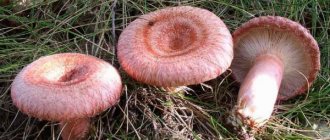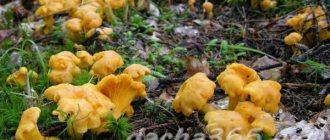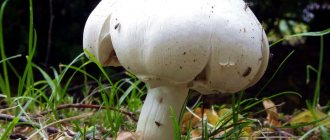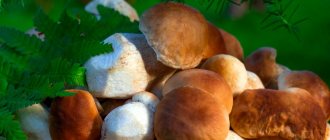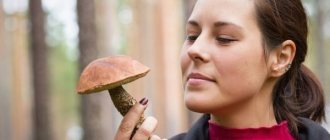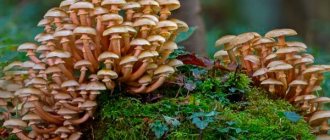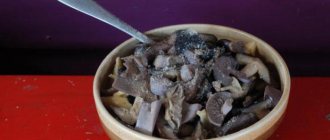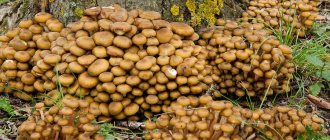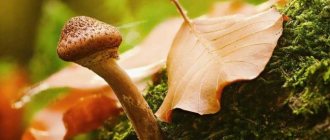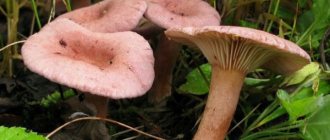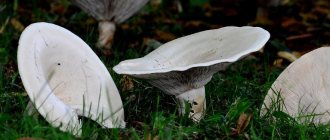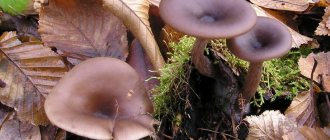It’s good if an experienced mushroom picker goes into the forest. He knows what he is looking for and does not make dangerous mistakes. But if the experience of “silent hunting” is not enough, then it is worth getting as much information as possible from experts or on the relevant sites. And in order not to drown in the ocean of information, ask about mushrooms that are found in your area. For example, what kind of mushrooms grow on stumps? If you don't know, let's look together.
What trees do honey mushrooms grow on?
Regardless of edibility and growing season, hemp mushrooms appear on both dead and living trees. In particular, they breed on rotten or damaged wood. However, mountain regions are characterized by the appearance of honey mushrooms on coniferous trees: spruce, cedar, pine and larch. Such mushrooms are distinguished during tasting by their bitter aftertaste and dark-colored stem, which does not in any way affect their nutritional value. Summer varieties from forest areas grow up to 7 cm in height with a stalk diameter of 1 cm. Usually the stalk has a steep velum and is covered with small scales.
Photos of honey mushrooms on trees that have suffered disease or mechanical damage:
Food in the forest. 1.1.3. Tree fungi - tinder fungi
The content of the article
Table of contents:
General characteristics of wood-decaying fungi
Substrate is a nutrient medium for polypores. Is tinder a pasture or a source of tinder? Oyster mushrooms Other types of tree fungi Parasitic lamellar mushrooms - honey mushrooms Wood-destroying fungi of the genus squamosus and hypholomas, false (poisonous) mushrooms Real tree polypores Growth characteristics and age-related changes in polypores
General characteristics of wood-decaying fungi
Polypores are macromycete fungi that grow on trees and often kill the host tree. With this word, a stereotype immediately emerges: a kind of canopy on a tree (photo 1). In fact, tinder fungi are very diverse, there are more than 600 species. This is not a taxonomic group - it includes representatives of different families of the class Basidiomycetes , which have different appearances and are united by only one common ecological feature: they are all wood-destroying xylotrophs , feeding on dead or living wood, in the latter case parasitizing on the tree and eating their host.
1. Characteristic multi-tiered groups of visor-shaped basidiomas (fruiting bodies) of the fringed polypore Fomitopsis pinicola on a living Caucasian fir tree. This tinder fungus settles on different species, both coniferous and deciduous (photo from the site czl23.ru)
Occupying isolated ecological niches of tree parasites, xylophagous polypores (from the word “phagos” - “devour”, Greek) settle, as a rule, on old and weakened trunks, gradually destroying them and making room for new forest generations (although there are “aggressors” ", fatally and quickly affecting young and healthy trees). Others are saprophages ( saprotrophs ), feeding on already dead wood of dead wood trunks, stumps or dead wood, half-rotted twig waste and roots. Typically, fungi included in these subgroups successively replace each other on a woody substrate: xylophagous parasites “prepare the ground” for saprophages and saprotrophs. And all together they participate in the eternal cycle of substances in the forest ecosystem, decomposing wood and processing lignin and cellulose into simpler and more easily digestible organic compounds (cellulose, for example, is decomposed into simple sugars such as glucose ).
Many tinder fungi cause significant damage to forestry and the wood processing industry. But at the same time, almost all polypores have beneficial properties for humans as sources of antibiotics , antioxidants and many other valuable medicinal substances. Polypores also played an important role in human history as suppliers of tinder (not only a campfire, but also the first firearm).
Typically, tinder fungi exhibit a certain selectivity towards tree species, although narrow specialization is not common among them. For example, the false aspen polypore Phellinus tremulae (photo 2) is an obligate xylophagous parasite of aspen (narrow specialization). The edible birch sponge, or birch piptoporus betulinus (photo 2a), also, like the aspen polypore, is a “monogamous” species, settling on birch, but only on already dead trunks (that is, it is an obligate saprophage of birch). Another aspen lover, the fox polypore Inonotus rheades (photo 2b), only prefers aspen, but also parasitizes other species. At the same time, it lives on both dead and living trunks. Its relative, the tinder fungus Inonotus obliquus, widely known under the name of the famous birch chaga (photo 6d), also prefers one tree species - birch, although it is found on aspen, alder, and rowan. This tinder fungus, like the fox tinder fungus, lives on both living trees and dead ones, but at the same time it itself undergoes two stages of development. Chaga is a sterile (non-spore-bearing) fungal growth on a living stem. And only after the fungus kills the tree, it moves into the second stage of development - spore-bearing. The bordered tinder fungus, or pine fungus Fomitopsis pinicola, despite its species-specific name, settles on dead and living trees of all kinds - both coniferous and deciduous (photo 2c, as well as 1). The sulfur-yellow tinder fungus Laetiporus sulphureus (photo 2d) also parasitizes almost all trees indiscriminately, but those letiporus that settle on coniferous trees cause poisoning in people (therefore mycologists have recently divided this species into 2-3 independent species, separately highlighting pine and spruce sulfur-yellow tinder fungi).
2. False aspen polypore Phellinus tremulae = obligate parasite of aspen, affects living aspen trunks older than 40 years and does not settle on any other trees (photo by V. Kapitonov on the website mycoweb-stv.ru)
2a. Piptoporus betulinus is an obligate saprophage of birch. It feeds only on its wood, but already dead (photo by S. Krivosheev on the website mycoweb-stv.ru)
2b. The inedible fox polypore Inonotus rheades only prefers aspen, but also parasitizes some other species. Settles on dead trees, but can also attack living ones (photo by O. Seliverstov on the website mycoweb.narod.ru) 2c. Bordered tinder fungus, or pine fungus Fomitopsis pinicola on a stump. Barnaul ribbon forest (photo by D. Kuzmin on the website grib22.ru)
2g. Sulfur-yellow tinder fungus Laetiporus sulphureus (photo from Wikipedia)
Substrate is a nutrient medium for tinder fungi
Regarding the substrate (living trunks or dead organic matter) on which tinder fungi settle, we also observe a strong scatter. Some types of polypores - xylophages - are able to develop only on living trees (for example, false oak polypore - photo 3), which is due to their species-specific need for vitamins produced by this particular type of tree. Others - saprotrophic - grow only on dead wood prepared by previous xylophages (photos 3a and 3b). And, for example, the edible tinder fungus Albatrellus ovinus generally grows on the ground - not even on dead wood or stumps, feeding on almost decomposed wood of twig waste (photo 3c). And there are many forms of “omnivores” that feed on both dead organic matter on the ground and drink the juices of living trees, sitting on trunks and branches. In this case, it is advisable to talk not about species or population consortia (as in the case of the previously described fistulina ), but about an ecosystem consortium, relating to the entire type of forest as a whole (for example, oak forests, complex forests), or even more broadly - deciduous or coniferous forests .
3. The xylophage false oak polypore Phellinus robustus is found only in oak forests, parasitizing specifically on live oaks, although sometimes it settles on the trunks of other accompanying deciduous trees, but also only living ones (photo by T. Svetlova on the website mycoweb.narod.ru) 3a. The saprophage Trametes versicolor settles on dead trunks of deciduous trees and even on the log walls of houses (photo by T. Svetlova on the website mycoweb.narod.ru)
3b. Antrodiella pallescens is a saprophage that grows on dead and fallen birches killed by the polypore fungus Fomes fomentarius (it is in the upper part of the frame). Sometimes it grows on the tinder fungus itself (photo by T. Svetlova on the website mycoweb-stv.ru)
3c. The edible saprotrophic tinder fungus Albatrellus ovinus grows on the soil in clearings and forest edges in coniferous forests, feeding on already half-decomposed twig waste (photo by A. Myasnikov on the website mycoweb.narod.ru)
Tinder fungus - pasture or source of tinder?
By and large, the liver fungus fistulina . However, classic tinder fungi have one more property that is not very characteristic of fistulina - as they mature, they become woody and turn into “plywood” or “cork.” From a consumer point of view, this property is much more important than appearance or type of nutrition: the life of an edible tinder fungus as our “pasture” is very short.
Among the tinder fungi there are few poisonous ones, but almost all of these mushrooms are inedible due to the hardness and woody nature of the fruiting bodies. Those that are edible are suitable for food only at a young age. It should also be pointed out that among the edible polypores, the absolute majority produce a short-lived fruiting body ( basidiome ), while many inedible ones form perennial woody fruiting bodies, sometimes living even 20-30 years (photos 4 and 4a). It is these perennials with a characteristic tinder-like shape in the form of a visor that give us real tinder.
4. “Classic” perennial and inedible (edible only at an early young age) polypore Fomes fomentarius on dead birch. The “annual rings” are clearly visible. “Fomes” in Latin means “tinder,” that is, the mushroom is called “tinder tinder” (photo by T. Svetlova on the site mycoweb.narod.ru) 4a. Also a “classic perennial”, the flat tinder fungus Ganoderma applanatum on an oak stump (photo by T. Svetlova on the website mycoweb.narod.ru)
Oyster mushrooms
In appearance and lifestyle, oyster mushrooms are close to tinder fungi (in particular, oak oyster mushrooms live on oak trees - photo 5), however, these mushrooms belong to lamellar basidiomycetes . Tubular or spongy basidiomycetes (photo 5a).
5. Oak oyster mushroom Pleurotus dryinus has a lamellar hymenophore (photo from the site mycoweb.ru)
5a. Tubular (spongy) hymenophore of the “classic” pink tinder fungus Fomitopsis rosea close-up (photo by T. Svetlova on the site mycoweb.narod.ru)
Other types of tree mushrooms
In addition, there are many species of other tree fungi that occupy niches similar to tinder fungi, oyster mushrooms, and liverworts, but are very diverse in appearance and not at all similar to tinder fungi (however, often not at all similar to mushrooms in our usual understanding - photo 6, 6a, 6b, 6c, 6d). Unlike true tinder fungi, these do not become woody with age, just like oyster mushrooms. Among them there are also edible and poisonous, which will be described in the appropriate paragraphs. And the real tinder fungus birch chaga mentioned above does not look like anything mushroom at all (photo 6d). And this is the only mushroom that is edible in a state of complete lignification - it is brewed like tea.
6. Edible winter polypore Polyporus brumalis from the Polyporaceae family - stands on a stalk like a “classic” terrestrial mushroom. Saprotroph. Found on deciduous trees (birch, alder, linden, rowan, willow) or rotting wood immersed in the soil (photo by M. Karpov on the site mycoweb.narod.ru)
6a. Schizopora paradoxa Schizopora paradoxa - found on fallen trees and dead wood of various deciduous species (here on birch). A widespread species of tinder fungus, but in Latvia it is included in the Red Book (photo by T. Svetlova on the site mycoweb2.narod.ru) 6b. Hedgehog or Hericium coralloides is an edible tinder fungus from the Hericium family. Grows on stumps and dead wood of deciduous trees - aspen, oak, but more often birch (photo by O. Seliverstov on the website likonsta.ucoz.ru) 6th century. Annual fruiting body of the tinder fungus Hericium erinaceum on the trunk of a sessile oak. Gelendzhik TLV, September–October 2009 (photo from the site czl23.ru)
6g. On decaying wood, especially often on dead wood and branch waste of elderberry, a completely edible mushroom Auricularia auricola judae grows from the class of heterobasidiomycetes, which is called in Latin “Judas’s ear” for the peculiar shape of its gelatinous fruiting bodies (photo from the site animalworld.com.ua)
6d. The edible tea and medicinal tinder fungus Inonotus obliquus, better known as the famous birch chaga, does not look like a mushroom, but like a cancerous growth of wood. Parasitizes living trees. But its spore-bearing stage appears only when the tree dies (photo by V. Afanasyev on the website mycoweb.ru)
Lamellar parasitic mushrooms - honey mushrooms
Parasitic fungi that settle on living wood and very quickly destroy it also include many lamellar fungi (along with oyster mushrooms). For example, the famous autumn honey fungus Armillariella mellea (photo 7), its close relative the thick-legged honey fungus Armillaria gallica (photo 7a), their distant relative from the family of the summer honey fungus Kuehneromyces mutabilis (photo 7b) and the completely unrelated winter flammulin honey fungus Flammulina velutipes (photo 7c). However, these mushrooms, well known to the population, are not considered in our directory, but will only be mentioned as consorts of the corresponding tree species.
7. Fruiting bodies of the autumn honey fungus Armillariella (Armillaria) mellea on the stump growth of pedunculate oak, September–October 2009. This fungus affects about 200 species of trees and shrubs, and even parasitizes herbaceous plants such as potatoes (photo from the site czl23.ru ) 7a. The honey fungus Armillaria gallica settles both on dead wood and on the forest floor (photo by S. Arslanov on the website mycoweb-stv.ru)
7b. The summer honey fungus Kuehneromyces mutabilis from the strophariaceae family is a twin of the true armilaria honey mushrooms. Also an edible and tasty mushroom, growing in large groups on half-decomposed stumps (photo by Jerzy Opioła on wikimedia.org)
7th century “Winter honey fungus”, also known as the winter flammulina mushroom Flammulina velutipes, is completely unrelated to other honey mushrooms (it is from the family of honey mushrooms), but it also aggressively destroys living trees, although it does not disdain dead stumps (photo from the site wikigrib.ru)
Wood-destroying fungi of the genus scaly and hypholoma, false (poisonous) honey mushrooms
Wood-destroying fungi of the genus Pholiota (photos 8, 8a and 8b) and Hypholoma (photos 8c, 8d and 8e) from the strophariaceae family are also widespread. These are not known to everyone, but the population often confuses some of the scales and hypholomas with real honey mushrooms - they are so similar. Therefore, even their scientific Russian names often begin with the words “honey agaric” or “false honey agaric.” Edible flakes and hypholomas will be discussed in detail in the corresponding paragraphs.
8. Destructive scale Pholiota destruens - inedible due to its bitter taste and unpleasant odor. Interestingly, old mushrooms lose their bitterness and become sweetish, but by this time they become very hard (photo by T. Svetlova on the website mycoweb-stv.ru)
8a. Bitter and inedible tuberculate flake Pholiota tuberculosa (photo by T. Bulyonkova on the website mycology.su)
8b. The edible golden scale Pholiota aurivella is similar to the summer honey fungus (photo by D. Ageev on the website mycology.su)
8th century Brick-red false honey fungus Hypholoma lateritium is a poisonous twin of real honey mushrooms, settles on oak stumps (photo by T. Svetlova on the website mycoweb-stv.ru)
8g. The sulfur-yellow false honey fungus Hypholoma fasciculare is a deadly poisonous twin of the true honey mushrooms. It grows there and in the same way as autumn honey fungus (photo from bracomfotografie.wordpress.com)
8d. Hypholoma capnoides is an edible counterpart to the summer honey fungus. It grows supposedly on the soil, but in fact – on branches and pieces of wood buried in the soil (photo by T. Svetlova on the website mycoweb-stv.ru)
True tree polypores
It has already been said above that tinder fungi are not a taxonomic group, but an ecological one into which mushroom pickers unite representatives of different families of the class Basidiomycetes . Not all mushrooms found on trees, stumps and dead wood are popularly called tinder fungi - but only those that have the “classic” shape of a visor on a tree or stump, a tubular (spongy) hymenophore and become lignified with age. In our review, they will also be considered from the perspective not of scientific taxonomy, but from a consumer one, where the main factor is not kinship, but edibility and habitat. From this point of view, according to morphoecological characteristics, we will divide them into “true” (classics of the genre), “polyporous” (with legs) and lamellar (oyster mushroom-shaped). Other woody (but not lignifying!) mushrooms such as honey mushrooms, scales, hypholomas and exotic hericia or auricularia are considered separately.
Below, two figures (photos 9 and 9a) show the morphological types of fruiting bodies (basidiomes) and methods of attachment of the stalk in woody tinder fungi. The figures are taken from the monograph by T.V. Svetlova and I.V. Zmitrovich “Tinder fungi and other wood-dwelling aphyllophorous fungi” on the website mycoweb-stv.ru.
9. Morphological types of fruiting bodies and methods of stalk attachment in tree fungi according to the classification of L. Ryvarden and RL Gilbertson (1993). The diagram is given according to the monograph by T.V. Svetlova and I.V. Zmitrovich “Tinder fungi and other wood-dwelling aphyllophorous fungi” on the website mycoweb-stv.ru
9a. Types of fruiting bodies of “true” polypores without stalk according to the classification of L. Ryvarden (1976). Same source
When identifying tinder fungi, an important role is played by the lower spore-bearing surface of the fruiting body - the hymenophore. Here they pay attention to its color, as well as the shape, structure and size of the pores (tubes) or plates. There are three main types of hymenophore: tubular , labyrinthine and lamellar . They are shown in the figure by T. Svetlova and I. Zmitrovich in their above-mentioned monograph on the website mycoweb-stv.ru. (photo 9b).
9b. Types of hymenophores according to T.V. Svetlova and I.V. Zmitrovich. Same source
The most common type of hymenophore of tinder fungi is tubular. It is present in all true and most polyporous polypores without exception.
Features of growth and age-related changes in tinder fungi
The mycelium of tinder fungi lives inside a woody substrate (a living tree trunk or branch, a stump or dead wood, half-decomposed twig waste and pieces of wood on the soil), on the surface of which fruiting bodies - basidiomas - are then formed. From the moment the mycelium begins to develop until the first fruiting bodies form, a long period passes. At the same time, as you already know from the example of the liver fungus fistulina, as they grow and “mature”, basidiomas change greatly in appearance. Fruit bodies appear on the surface more often in the form of tubercles or flat spots and gradually acquire the volume and shape of a ripe mushroom. Moreover, even for “adult” fruiting bodies, the shape can vary greatly depending on the nature of the substrate (hard living wood, hollow or crack in the trunk, mossy stump, buried branch waste) and its orientation in space (vertical trunk, horizontal branch, crack) (photos 10 and 10a, 10b and 10c, 10d and 10d). If cap mushrooms are quite easily identified at a very early age, then wood tinder fungi at the initial stages of development are often impossible to identify without resorting to special research. The only thing that saves you from poisoning is that there are very few poisonous tinder fungi.
10. Classic of the genre = true polypore Fomes fomentarius on a vertical beech trunk. Edible mushroom and main source of tinder. Adler, February 16, 2015 (photo from gribnikidonbassa.ru)
10a. And this Fomes fomentarius, which grew from below on a horizontal branch, does not at all resemble its classic hoof-shaped form. For comparison, see the inset in the lower right corner of the photo. Moscow region (photo by T. Svetlova on the website mycoweb-stv.ru)
10b. Inedible tinder fungus Ganoderma australe. Adler, February 16, 2015 (photo from gribnikidonbassa.ru)
10th century But the author of the photograph could not identify this ganoderma (presumably also southern - australe; photographed in the same place and at the same time as in the previous photo) (photo from the site gribnikidonbassa.ru)
10g. Inedible tinder fungus Trametes hirsuta on a dead rowan tree trunk. Trans-Ili Alatau, Kazakhstan (photo by A. Fokina on the website innature.kz)
10d. And this coarse-haired tramethes - also on a horizontal branch - “stuck” to it with the upper surface of the fruiting body. Moscow region (photo by T. Svetlova on the website mycoweb-stv.ru)
It should be said that not all “real” tinder workers are suppliers of real tinder. There are several families of false polypores (but classic in appearance) that become woody and harden with age. Polypores that produce tinder do not become woody, but become corked: their fruiting body inside contains spongy cork-fibrous tissue, which is used to make tinder using a rather complex and time-consuming technology in the field (at home, it is enough to simply soak it with saltpeter). Tinder-containing fungi include mushrooms in which the upper surface of the fruiting body is always smooth or rough, but not cracked. Among the most widespread are representatives of the genera Fomes (the only species of Fomes fomentarius, which is also the main supplier of tinder), Fomitopsis and Ganoderma .
Anatoly Levin
What do hemp mushrooms look like?
Such mushrooms are difficult to confuse with other mycelium, because they have characteristic distinctive features. Poisonous analogues are also distinguished by certain characteristics, so it is almost impossible to get poisoned by mushrooms. It is worth noting that inedible hemp mushrooms are characterized by a low level of toxicity, which makes them dangerous with a low degree of poisoning. Basically, the autumn honey fungus parasitizes trees and affects over 200 species per year. Colonies of the fungus can be recognized by the ringed growth pattern around the stump. Single copies are extremely rare.
Autumn honey fungus grows for only a few months on the stumps of felled birch trees. Popularly it has received several names: autumn mushroom, honey fungus, Uspensky mushroom. It is found in swampy birch forests, where there are a lot of rotten trees and stumps. In coniferous areas, honey mushrooms are rare, although you can find clusters of them near old spruce trees. Winter hemp mycelium grows at the base of any felled tree on the north side, in swampy areas.
Photo and description of hemp mushrooms
Like any forest mushroom, honey fungus has several false doubles, which you need to be able to identify by appearance. With such knowledge, the risk of poisoning from the harvest is eliminated. Each species grows under certain weather conditions. Also, external characteristics have their own characteristics, which prevents an edible mushroom from being confused with a poisonous one.
False hemp mushrooms
Preferably, inedible honey mushrooms grow on rotten stumps, which during life were affected by root rot, cancer or earthen insects. In appearance, the fruiting body can be distinguished by its bright cap, which has a delicate pinkish or yellowish-brown tint. The most dangerous ones are always bright brown or orange in color, with the exception of color being the sulfur-yellow honey fungus. The surface of the cap is smooth, without scales. The mushroom is slippery to the touch and becomes sticky after rain. There is no abrupt velum under the cap; the spore plates quickly acquire a dirty olive, green or blue tint. I advise mushroom pickers to first feel the aroma of the mycelium, and if there is a smell of earth and mold, then the mycelium is poisonous. These include:
- Poppy false fungus. It looks and tastes like summer honey fungus. Can be recognized by its bright orange stem, which turns yellow closer to the cap. The height of the mycelium reaches 8-10 cm, gray plates grow to the stem.
- Brick red. It is considered conditionally edible and is very bitter when tasting. The cap is large with a red-brown color, growing up to 10 cm in diameter. When cut, the stem of the mushroom is hollow.
- Sulfur yellow. A mushroom with a small pale yellow cap and a high stem - 10-12 cm. It has a pungent and unpleasant odor. Grows in numerous colonies on forest stumps. The young mycelium grows in the form of a bell.
Important! The poisonous mycelium instantly turns black at the cut site, the pulp gives off dampness and turns green along the inner edging of the cavity.
Edible hemp mushrooms
By their nature, honey mushrooms feed on the remains of stumps that have not been infected with a serious disease. Edible mycelium is characterized by its appearance - a thin stalk with a ring of film from the middle of the mushroom. The color of the honey mushroom pulp depends on the area where the stump grows. Colonies growing near poplar have a copper-yellow hue, on stumps of coniferous trees - reddish or brown, on oak or elderberry - brown, gray. Healthy plates are always creamy or yellowish-white. Mushrooms are endowed with a subtle clove aroma and a sweet and sour aftertaste. They grow in the same forests as their inedible counterparts and can coexist on nearby stumps, which does not in any way affect the quality of real mushrooms.
Harmless honey mushrooms are usually called autumn, winter, summer and meadow varieties of mycelium. The former have a characteristic and memorable cap, the surface of which is covered with small scales. The fruit body has a pleasant mushroom aroma, the consistency of the stem is light yellow and fibrous. The autumn season of hemp mushrooms begins at the end of August and lasts until mid-October. Summer and meadow ones are very similar in appearance: medium-sized mycelium with a cap diameter of 5 cm and a stem height of up to 10 cm, found in meadows and forests. The only difference: meadows do not grow on stumps; their family appears in the shape of a circle in small clusters.
A bright representative of winter mushrooms appears with the beginning of the winter thaw on old poplar or willow stumps. The mushroom stems are hollow and velvety to the touch. The fruiting body grows up to 8 cm in height and 3-4 cm in diameter. The hat has a glossy sheen and is ocher-brown in color. The stem is hollow, the flesh is not bitter, and gives off a pleasant smell. The spore plates are always light brown or cream in color.
Important! Overgrown edible fruiting bodies often lose not only their velum, but also their taste and nutritional value, and are only suitable for growing new mycelium.
INEDIBLE mushrooms. Caution INEDIBLE mushrooms
We continue the mushroom theme during the season.
If you have long wanted to go mushroom picking, but didn’t understand it well enough, my article will help you. Click on the blue link and read
So the most famous inedible mushroom is, of course, fly agaric. You can easily recognize it by its red cap with spots.
fly agaric
It doesn't only come in red.
Meet the panther fly agaric
fly agaric
As you can see, the colors are different, but everyone has spots on the cap.
Bile mushroom
Gall fungus is also called false white fungus. He looks just as strong. And it can be similar to boletus and boletus. You can distinguish them by the dark pattern on the leg. And when broken, the flesh turns pink. The porcini mushroom remains white.
To make sure that it is a gall mushroom, you need to lightly lick the bottom of the cap - it will be bitter
gall mushroom
gall mushroom
white on the left, gall mushroom on the right
False chanterelles. They are distinguished by a brighter color and the presence of a spot on the cap; the edge of the cap is lighter. In general, the color is not uniform, as in normal ones. False ones contain more toxins than regular ones. You can eat them, but you need to soak them for a couple of days for them to come out. I think it’s better not to take risks, but to look for good chanterelles
orange false chanterelles
false chanterelles
And finally, false honey mushrooms.
The main feature is the presence of a ring-shaped skirt under the hat. False honey mushrooms do not have a ring.
false honey mushrooms. No ring
ordinary honey mushrooms
Real honey mushrooms smell very pleasant. False ones are more moldy. Also pay attention to the scales on the cap. False ones will have a smooth cap.
Why do honey mushrooms settle on stumps?
Since honey mushrooms belong to the class of parasitic fungi, it is logical to assume that a favorable habitat for them is a stump affected by the disease. Honey mushrooms found on a tree trunk indicate the presence of an infection that has already penetrated deeply into the trunk. The mycelium does not grow immediately, but with its appearance, accelerated destruction of the wood occurs. First, the development of saprophytes occurs, then the basidal fruiting bodies appear. They transform the habitat from acidic to alkaline, after which cap mushrooms grow and the tree completely loses its shape. Therefore, honey mushrooms grow on stumps for only a few years, then the habitat loses value. Also, the stump of a dead tree is rich in cellulose, which the mycelium feeds on. This type of parasitic fungus can be called a forest orderly, because thanks to their growth and reproduction, young trees remain healthy.
How honey mushrooms begin to grow on a stump
When a tree receives mechanical damage or becomes infected with a disease, a gradual process of death of the bark and other parts of the trunk begins. Each variety of honey mushroom has its own habitat preferences. The false mushroom develops only on dead wood of coniferous trees; edible specimens can be found almost anywhere in a certain season. Mycelial growth begins when spores enter the site of damage. Next comes the development of imperfect microorganisms that feed on residual living cells. They then progress into the basidal mycelium. The habitat is acidified, and intermediate decomposition products go into food. As soon as cellulose reserves are depleted, other types of parasitic fungi appear that break down protein and fiber. At the stage of loss of shape and integrity, the tree becomes rotten, overgrown with moss and other microorganisms, which ultimately leads to the beginning of the development of honey mushrooms. They mineralize organic cells, thereby surviving off the dead stump.
Controversy
On the Internet you can find a huge amount of information about the toxicity of this mushroom or, conversely, about its benefits and the possibility of using it as food. Some sources say that the flu is inedible, and using it in cooking can result in problems with the gastrointestinal tract or simple eating.
Others, on the contrary, claim that from time immemorial they have been eating this mushroom, collecting it in the forests, and when properly prepared it is not only not dangerous, but also useful.
Indeed, in many areas this mushroom is considered edible and is used with pleasure. Moreover, its taste is very pleasant, spicy, and can decorate any dish. Moreover, the brick-red false honey fungus has doubles that are very dangerous for consumption.
We can agree that the mushroom should never be consumed . Light processing is also not suitable. In order to completely protect yourself and your family members, you need to boil the mushroom in boiling water at least several times and only then expose it to further heat.
The first mentions of this mushroom appeared in the 19th century. And even then it was considered a controversial mushroom, since some were poisoned when consumed, while others, on the contrary, considered it an excellent addition to food.
In any case, forewarned is forearmed.
Article on the topic - Yellow-red row (red honey mushrooms, yellow-red honey mushroom): a woody edible mushroom.
How many days does it take for hemp mushrooms to grow?
Mycelium growth and its speed depend on factors such as habitat temperature, humidity, and the presence of beneficial organisms. Favorable air temperature for germination of fruiting bodies is from + 14 to + 25 ° C. It is worth noting that this is a suitable climate for meadow mushrooms. For varieties of autumn, winter and spring honey mushrooms that grow on stumps, + 3 °C is enough for the development of spores to begin. In such conditions, fruiting bodies germinate in 2-3 days. If the temperature reaches + 28 °C, the processes stop. When there is good soil moisture in the range of 50-60% and an acceptable temperature, the mushrooms actively grow and bear fruit several times during the season. The leg's pace may stop for 24 hours if worms or insects are present in the soil. Full ripening occurs on days 5-6.
After the autumn rain, you can go out for honey mushrooms for 2-3 days. It is also worth considering September and October fogs. After their retreat, you can notice an increase in the yield on the stumps. Autumn species can be found in November if the temperature was above zero. Here, the catalyst for growth is humidity, which honey mushrooms often lack. As for winter varieties, they can delay growth at the time of frost and continue it when the air temperature reaches 0 or + 7 ° C.
Where to collect hemp mushrooms
On the territory of Russia there are many climatic zones where you can find colonies of mycelium of any variety. Again, the arrangement of families depends on convenience and favorable conditions. Autumn species grow on coniferous wood, fallen trees, and are common in completely coniferous and mixed forests. Summer and spring hemp mushrooms primarily grow in deciduous forests. They can often be found on tree trunks: oak, birch, acacia, poplar, ash or maple. Winter mushrooms prefer oak stumps, on which it is advantageous to reproduce due to the nutritional value of the wood.
When to collect hemp mushrooms
The harvest season depends on the climatic factor in a particular area. You can go hunting for spring mushrooms from April to May. Along with edible specimens, you can find false mushrooms growing on trees similar to honey mushrooms. The summer harvest occurs in July and August. Then the autumn species begin to grow actively, from about the end of August to the beginning of November. Winter ones are rare, but if you go in search of mycelium in November or December, you can collect 1-2 layers of fruiting bodies.
Conclusion
False fungus is a very controversial flu. Some are afraid of it like fire, others are happy to use it in their kitchen, even deliberately going on a quiet hunt in search of it.
You decide for yourself whether to try false foam or not. Be sure to take this choice very responsibly, since your health is at stake. And of course, remember that trying this mushroom is strictly prohibited for pregnant women, children, and people with diseases of the gastrointestinal tract.
( 1 ratings, average: 5.00 out of 5)
